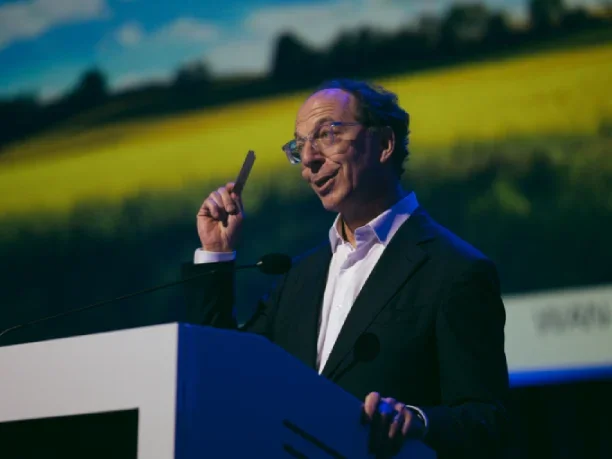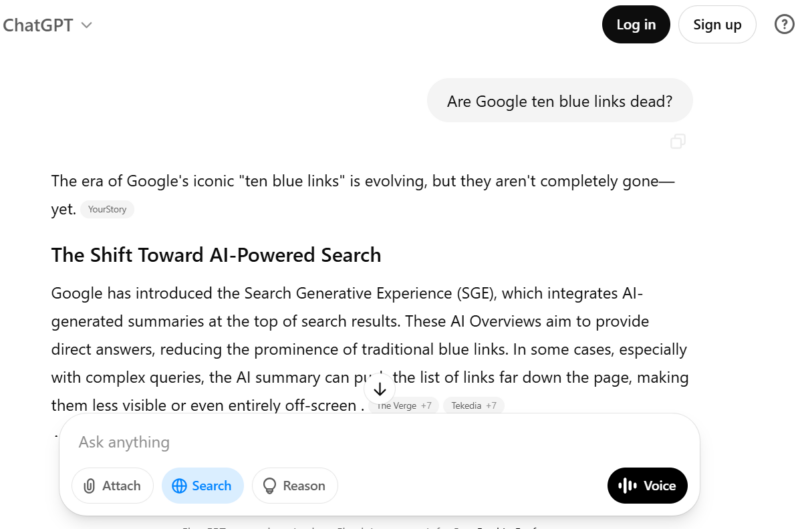
OpenAI’s chief of intellectual property and content has praised the “stunning results” of the past year of experimentation with AI technology in the news industry.
Tom Rubin also alluded to initial signals that news is popular on ChatGPT search but did not yet share any data – although SEO consultant Barry Adams separately told publishers at the conference not to be worried about AI chatbots including ChatGPT stealing traffic.
Rubin also took a potshot at the legacy model for search of Google’s “ten blue links”.
He was speaking for the second year running at WAN-IFRA’s World News Media Congress, held in Krakow on Tuesday.
Describing the shift in how users find information, he said: “Users increasingly like answers to be delivered quickly in a conversational and context-aware manner as opposed to the traditional land of an inefficient list of ten blue links.
“Consumers know that they can use natural language to get a better answer and go deeper into their particular interest. Tools like ChatGPT, which now has over 500 million weekly active users, are becoming part of their daily lives.”
ChatGPT now has 20 million paying users. Its total weekly usage is now five times bigger than this time one year ago.
ChatGPT’s search tool began rolling out on its website and in its apps in October and by February it was available to all paid and free users in regions where ChatGPT is available. Shopping features including personalised product recommendations were added last week.
OpenAI has signed deals with over a dozen major news and magazine publishers including News Corp, The Guardian, Axel Springer, the Financial Times, The Washington Post, Dotdash Meredith, Conde Nast, Hearst, Future, Le Monde, The Atlantic, Vox Media, Time, Axios and Schibsted.
The partnerships generally cover how the publisher’s content would be displayed in ChatGPT as well as the use of OpenAI tech. Citations tend to appear as names of websites at the end of paragraphs with an expandable “sources” section at the bottom of the answer.

At the same time OpenAI is being sued by The New York Times, eight dailies at Alden Global Capital, Ziff Davis, a coalition of Canadian publishers including the Globe and Mail and CBC, about 20 Indian publishers including the Indian Express Hindustan Times, and progressive outlets like Raw Story and AlterNet.
Rubin did not refer to the lawsuits in his keynote speech.
But speaking about search, he said: “Just over three months ago OpenAI integrated search functionality into the ChatGPT experience for all of our users. That provided a way to ensure that our users have access to reliable, accurate and up-to-the-minute information.
“While it’s still too early to have hard data, I can say that search has become one of the most popular features within ChatGPT with over one billion web searches conducted in a single week.”
Google says it receives more than five trillion searches per year, meaning 98 billion every week.
Rubin continued: “We also believe that there’s real demand from users to be informed about what’s happening in the world and news and current affairs is one of the most common search categories.
“While search has only been available for a few months, early signs are promising. Clear attribution and links and the resulting clicks that we’re driving to publisher sites are trending upward month over month.”
The conference heard in a separate session from SEO consultant Barry Adams of Polemic Digital who reassured publishers worried about AI search that ChatGPT is not growing “super fast”: “Yes, there is a growing userbase for the chatbots but it’s not anywhere near the huge upward curve people have been predicting. It’s a steady growth number…”
Adams said ChatGPT accounts for just 1% of referral traffic for an unnamed major publisher he has worked with and that it is “fractions of a percent” for most. “Yeah, I’m not worried about that – yet,” he said.
“You could argue that’s just because the chatbots don’t send traffic – and they don’t – but I don’t also see them as being competing with Google. In fact, the growth in Google queries aligned with the growth in AI use. There is increasing research pointing to the fact that people who use ChatGPT very heavily then also end up using Google more from having to verify what they’ve been told by ChatGPT.” He suggested this accounts for part of a 20% year-on-year growth in search queries on Google in 2024.
Adams also noted Semrush data showing that ChatGPT search behaviour is different to Google: just 30% of ChatGPT prompts have the same intent as the type of searches done in traditional search engines, with the other 70% “potentially related to problem-solving, brainstorming, or exploratory inquiries that don’t fit neatly into traditional categories”.
Adams said this means there are about 37.5 million search-equivalent queries on ChatGPT a day while Google handles 14 billion searches per day. “ChatGPT searches are not even a rounding error on Google’s daily uses so let’s not get carried away: ChatGPT is not replacing Google just yet.”
OpenAI’s Tom Rubin praises publisher ‘pace of exploration’
Rubin noted that it has been just two-and-a-half years since ChatGPT “introduced generative AI to the world” but said “the pace of exploration and adoption we’ve already witnessed has been extraordinary”.
He spoke about how the news industry has always had to adapt, comparing this era of AI to the arrival of the radio, TV and internet. He said the challenge was to ensure AI is “a force for good” and that publishers are “at the forefront of that effort”.
Citing some examples of what is working among publishers so far, Rubin said the “most effective AI tools are the ones that start not with flashy technology but with the practical needs of working journalists”.
He noted that multiple newsrooms are using custom versions of ChatGPT, saying they remove friction that slows journalists down by performing tasks with a repeatable set of instructions like summarising archive material, SEO tagging and reformatting for house style.
Rubin spoke about use cases that “break down barriers” such as through language translations, or that are “enabling journalists to reach audiences where they are”. He also spoke about the business value via use in adtech or to streamline sales cycles, saying AI can support all aspects of a business and that these functions are all “just the tip of the iceberg”.
Among the examples were US non-profit education industry news publisher Chalkbeat generating transcripts from meetings and summarising the highlights, Business Insider’s AI-powered search, Dotdash Meredith’s D/Cipher contextual ad-targeting technology, Outlier Media in Detroit using SMS to reach underserved communities with critical information in text form, and the Philadelphia Inquirer’s AI research assistant in its archives.
During his talk Rubin also announced the expansion of OpenAI’s partnership with media association WAN-IFRA, taking an AI catalyst programme that has been working with newsrooms in Europe, Asia Pacific, Latin America and South Asia into Australia and New Zealand as well. It is also adding an “advanced” track for newsrooms that are further along in their AI journeys.
Schibsted’s director of data and AI Juan Carlos Lopez Calvet told the conference later that morning that the publisher signed a deal with OpenAI because “we wanted to learn. We know that this is taking everybody by surprise. It’s happening very fast. And we think that we need to learn with perhaps one of the most relevant players in this field.”
He added that the second reason to do a deal was that if “we had the chance to partner in order to have a bit of a say or a bit of control of how our content is displayed in ChatGPT, we would really appreciate that. So the partnership allows us to work with them on how the links are displayed, how our data is displayed.”
Schibsted’s public-facing AI uses include chatbots on newsbrands Aftonbladet and VG, personalised summaries of what news people have missed since they last logged in, and a video generator that produces vertical video for use on screens on Oslo’s train line.
Email pged@pressgazette.co.uk to point out mistakes, provide story tips or send in a letter for publication on our "Letters Page" blog

